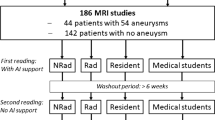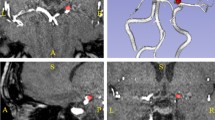Abstract
Purpose
Hemorrhagic transformation (HT) is an independent predictor of unfavorable outcome in acute ischemic stroke (AIS) patients undergoing endovascular thrombectomy (EVT). Its early identification could help tailor AIS management. We hypothesize that machine learning (ML) applied to cone-beam computed tomography (CB-CT), immediately after EVT, improves performance in 24-h HT prediction.
Methods
We prospectively enrolled AIS patients undergoing EVT, post-procedural CB-CT, and 24-h non-contrast CT (NCCT). Three raters independently analyzed imaging at four anatomic levels qualitatively and quantitatively selecting a region of interest (ROI) < 5 mm2. Each ROI was labeled as “hemorrhagic” or “non-hemorrhagic” depending on 24-h NCCT. For each level of CB-CT, Mean Hounsfield Unit (HU), minimum HU, maximum HU, and signal- and contrast-to-noise ratios were calculated, and the differential HU-ROI value was compared between both hemispheres. The number of anatomic levels affected was computed for lesion volume estimation. ML with the best validation performance for 24-h HT prediction was selected.
Results
One hundred seventy-two ROIs from affected hemispheres of 43 patients were extracted. Ninety-two ROIs were classified as unremarkable, whereas 5 as parenchymal contrast staining, 29 as ischemia, 7 as subarachnoid hemorrhages, and 39 as HT. The Bernoulli Naïve Bayes was the best ML classifier with a good performance for 24-h HT prediction (sensitivity = 1.00; specificity = 0.75; accuracy = 0.82), though precision was 0.60.
Conclusion
ML demonstrates high-sensitivity but low-accuracy 24-h HT prediction in AIS. The automated CB-CT imaging evaluation resizes sensitivity, specificity, and accuracy rates of visual interpretation reported in the literature so far. A standardized quantitative interpretation of CB-CT may be warranted to overcome the inter-operator variability.
Similar content being viewed by others
Data Availability
Data is available upon reasonable request from the corresponding author.
References
Goyal M, Menon BK, van Zwam WH et al (2016) Endovascular thrombectomy after large-vessel ischaemic stroke: a metaanalysis of individual patient data from five randomised trials. Lancet 387(10029):1723–1731. https://doi.org/10.1016/S0140-6736(16)00163-X
Albers GW, Marks MP, Kemp S et al (2018) Thrombectomy for stroke at 6 to 16 hours with selection by perfusion imaging. N Engl J Med 378(8):708–718. https://doi.org/10.1056/NEJMoa1713973
Nogueira RG, Jadhav AP, Haussen DC et al (2017) Thrombectomy 6 to 24 hours after stroke with a mismatch between deficit and infarct. N Engl J Med 378(1):11–21. https://doi.org/10.1056/NEJMoa1706442
Mistry EA, Mistry AM, Nakawah MO et al (2017) Systolic blood pressure within 24 hours after thrombectomy for acute ischemic stroke correlates with outcome. J Am Heart Assoc 6(5):e006167. https://doi.org/10.1161/JAHA.117.006167
Puntonet J, Richard ME, Edjlali M et al (2019) Imaging findings after mechanical thrombectomy in acute ischemic stroke. Stroke 50(6):1618–1625. https://doi.org/10.1161/STROKEAHA.118.024754
Nicholson P, Cancelliere NM, Bracken J et al (2021) Novel flat-panel cone-beam CT compared to multi-detector CT for assessment of acute ischemic stroke: a prospective study. Eur J Radiol 138:109645. https://doi.org/10.1016/j.ejrad.2021.109645
Kau T, Hauser M, Obmann SM et al (2014) Flat detector angio-CT following intra-arterial therapy of acute ischemic stroke: identification of hemorrhage and distinction from contrast accumulation due to blood-brain barrier disruption. Am J Neuroradiol 35(9):1759–1764. https://doi.org/10.3174/ajnr.A4021
Payabvash S, Khan AA, Qureshi MH et al (2016) Detection of intraparenchymal hemorrhage after endovascular therapy in patients with acute ischemic stroke using immediate postprocedural flat-panel computed tomography scan. J Neuroimaging 26(2):213–218. https://doi.org/10.1111/jon.12277
Leyhe JR, Tsogkas I, Hesse AC et al (2017) Latest generation of flat detector CT as a peri-interventional diagnostic tool: a comparative study with multidetector CT. J Neurointerv Surg 9(12):1253–1257. https://doi.org/10.1136/neurintsurg-2016-012866
Chen L, Xu Y, Shen R et al (2021) Flat panel CT scanning is helpful in predicting hemorrhagic transformation in acute ischemic stroke patients undergoing endovascular thrombectomy. Biomed Res Int 13(2021):5527101. https://doi.org/10.1155/2021/5527101
Obermeyer Z, Emanuel EJ (2016) Predicting the future - big data, machine learning, and clinical medicine. N Engl J Med 375(13):1216–1219. https://doi.org/10.1056/NEJMp1606181
Soun JE, Chow DS, Nagamine M et al (2021) Artificial intelligence and acute stroke imaging. AJNR Am J Neuroradiol 42(1):2–11. https://doi.org/10.3174/ajnr.A6883
Zeleňák K, Krajina A, Meyer L et al (2021) How to improve the management of acute ischemic stroke by modern technologies, artificial intelligence, and new treatment methods. Life (Basel) 11(6):488. https://doi.org/10.3390/life11060488
Zaidat OO, Yoo AJ, Khatri P et al (2013) Recommendations on angiographic revascularization grading standards for acute ischemic stroke: a consensus statement. Stroke 44(9):2650–2663. https://doi.org/10.1161/STROKEAHA.113.001972
Jiang X (2013) Patient radiation dose when using XperCT and rotational X-ray. Philips Healthcare. Murarrie, QLD, Australia. https://doi.org/10.13140/RG.2.2.14118.73281
Wang C, Nguyen G, Toncheva G et al (2014) Evaluation of patient effective dose of neurovascular imaging protocols for C-arm cone-beam CT. AJR Am J Roentgenol 202(5):1072–1077. https://doi.org/10.2214/AJR.13.11001
Maier IL, Leyhe JR, Tsogkas I et al (2018) Diagnosing early ischemic changes with the latest- generation flat detector CT: a comparative study with multidetector CT. AJNR Am J Neuroradiol 39(5):881–886. https://doi.org/10.3174/ajnr.A5595
Fiorelli M, Bastianello S, von Kummer R et al (1999) Hemorrhagic transformation within 36 hours of a cerebral infarct: relationships with early clinical deterioration and 3-month outcome in the European Cooperative Acute Stroke Study I (ECASS I) cohort. Stroke 30(11):2280–2284. https://doi.org/10.1161/01.str.30.11.2280
Yoon W, Jung MY, Jung SH et al (2013) Subarachnoid hemorrhage in a multimodal approach heavily weighted toward mechanical thrombectomy with solitaire stent in acute stroke. Stroke 44(2):414–419. https://doi.org/10.1161/STROKEAHA.112.675546
Pedregosa F, Varoquaux G, Gramfort A et al (2011) Scikit-learn: machine learning in Python. J Mach Learn Res 12:2825–2830
LeCun Y, Bengio Y, Hinton G (2015) Deep learning. Nature 521(7553):436–444. https://doi.org/10.1038/nature14539
Dekeyzer S, Nikoubashman O, Lutin B et al (2017) Distinction between contrast staining and hemorrhage after endovascular stroke treatment: one CT is not enough. J Neurointerv Surg 9(4):394–398. https://doi.org/10.1136/neurintsurg-2016-012290
Sallustio F, Pampana E, Davoli A et al (2018) Mechanical thrombectomy of acute ischemic stroke with a new intermediate aspiration catheter: preliminary results. J Neurointerv Surg 10(10):975–977. https://doi.org/10.1136/neurintsurg-2017-013679
Ma J, Ding Y, Cheng JCP, Tan Y, Gan VJL, Zhang J (2019) Analyzing the leading causes of traffic fatalities using XGBoost and grid-based analysis: a city management perspective. IEEE Access. https://doi.org/10.1109/ACCESS.2019.2946401
Author information
Authors and Affiliations
Contributions
Dr. Da Ros, Dr. Duggento, and Dr. Maestrini contributed substantially to the study’s conception and design. Material preparation and data collection were performed by Dr. Da Ros, Dr. Bellini, Dr. Pitocchi, Dr. Mascolo, and Dr. Maestrini. Neuroimaging analysis was performed by Dr. Da Ros, Dr. Pitocchi, and Dr. Maestrini. Statistical analyses were performed by Dr. Duggento, Dr. Cavallo, and Dr. Maestrini. All authors made a substantial contribution to data interpretation. The first draft of the manuscript was written by Dr. Da Ros, Dr. Duggento, Dr. Cavallo, and Dr. Maestrini. All authors revised critically previous versions of the manuscript. All authors read and approved the final manuscript.
Corresponding author
Ethics declarations
Ethics approval
All procedures performed in the study involving human participants were in accordance with the ethical standards of the institutional and/or national research committee and with the 1964 Helsinki Declaration and its later amendments. The local ethics committee approved prospectively data collection on patients undergoing EVT (Registro Sperimentazioni, R.S. 25/18). All the procedures performed were part of the routine care.
Informed consent
Informed consent was obtained from all individual participants included in the study. The authors affirm that human research participants provided informed consent for the publication of the images in Fig. 3A-F.
Competing interests
The authors have no relevant financial or non-financial interests to disclose.
Additional information
Publisher's note
Springer Nature remains neutral with regard to jurisdictional claims in published maps and institutional affiliations.
Rights and permissions
Springer Nature or its licensor (e.g. a society or other partner) holds exclusive rights to this article under a publishing agreement with the author(s) or other rightsholder(s); author self-archiving of the accepted manuscript version of this article is solely governed by the terms of such publishing agreement and applicable law.
About this article
Cite this article
Da Ros, V., Duggento, A., Cavallo, A.U. et al. Can machine learning of post-procedural cone-beam CT images in acute ischemic stroke improve the detection of 24-h hemorrhagic transformation? A preliminary study. Neuroradiology 65, 599–608 (2023). https://doi.org/10.1007/s00234-022-03070-0
Received:
Accepted:
Published:
Issue Date:
DOI: https://doi.org/10.1007/s00234-022-03070-0









